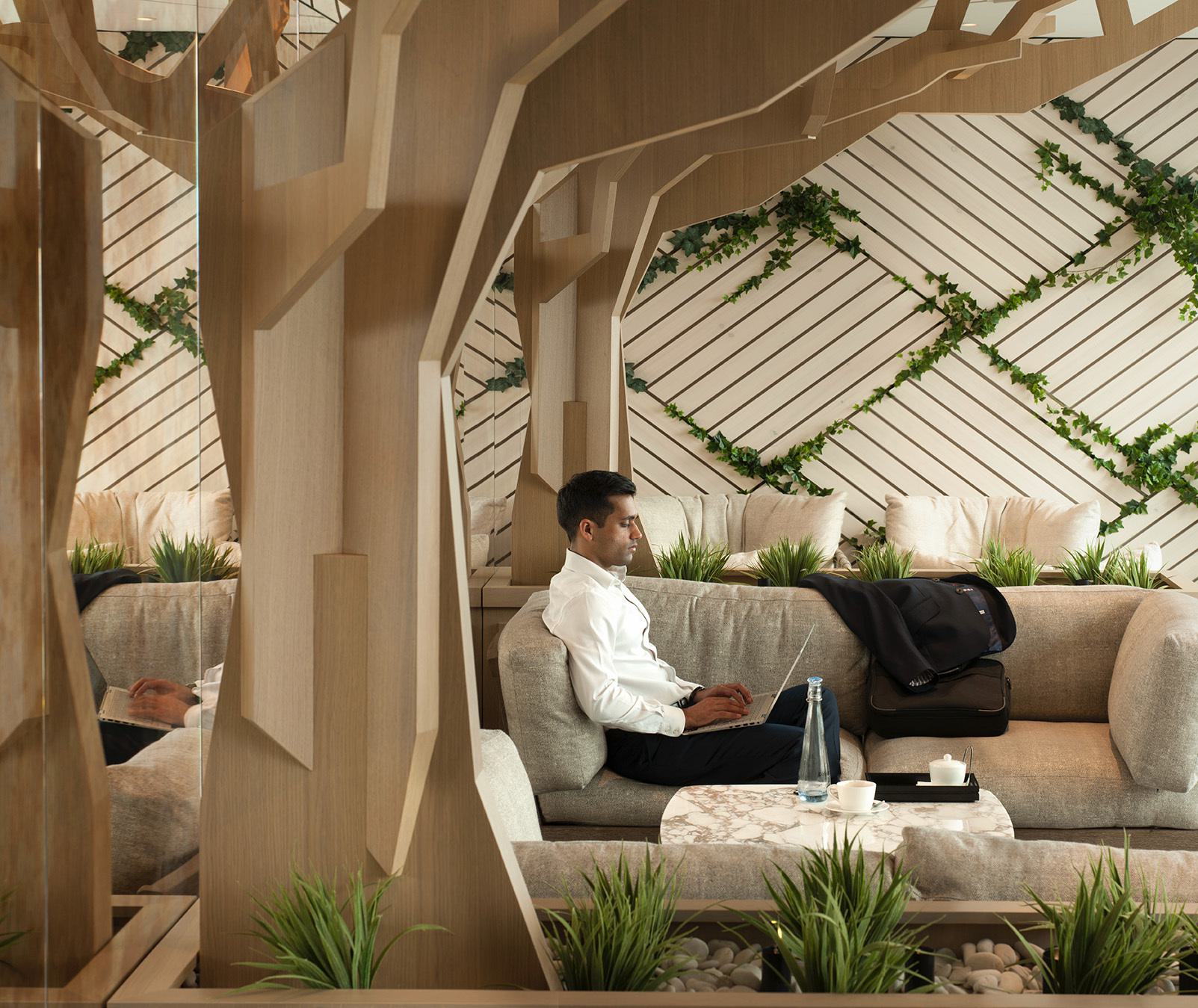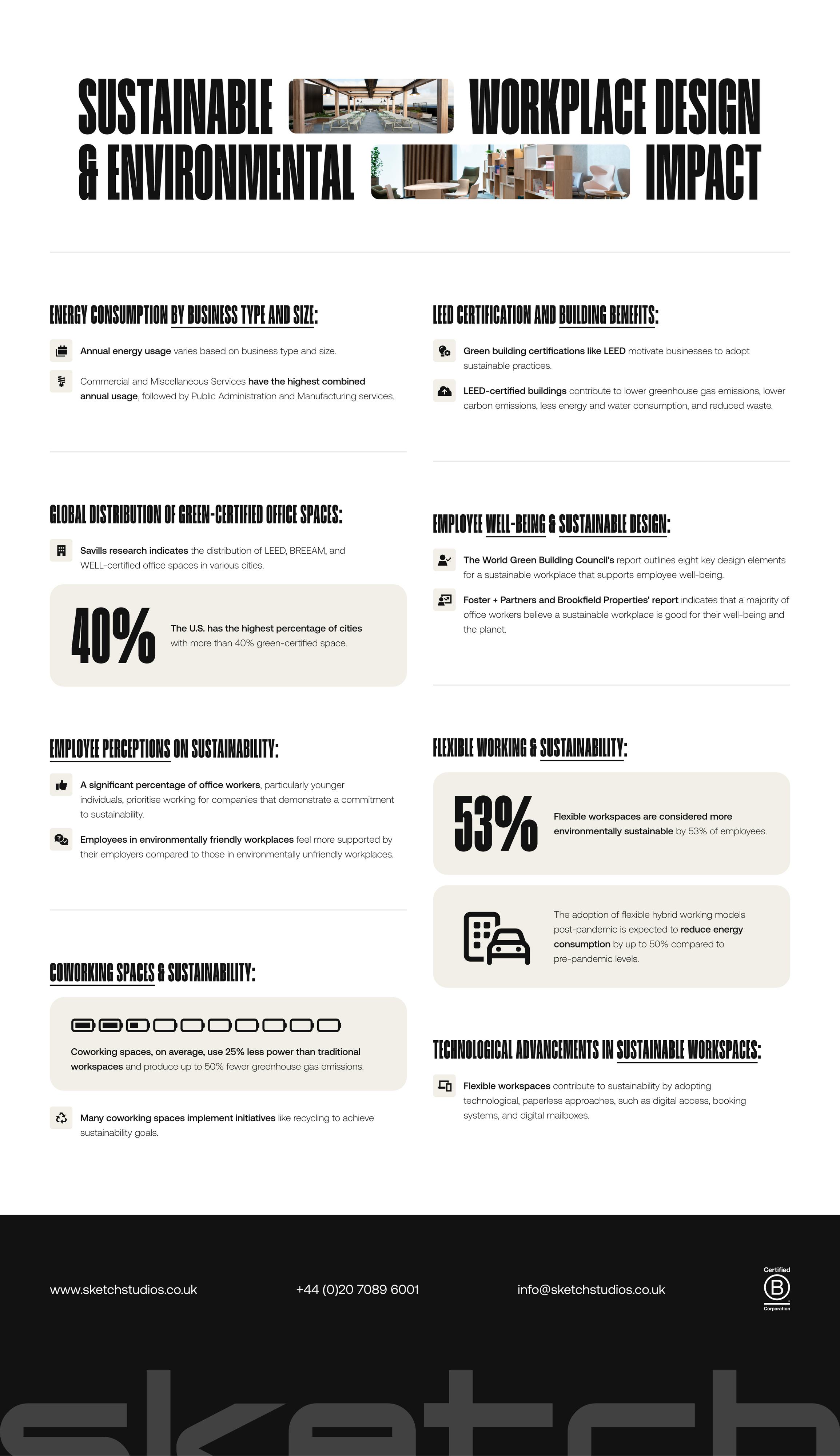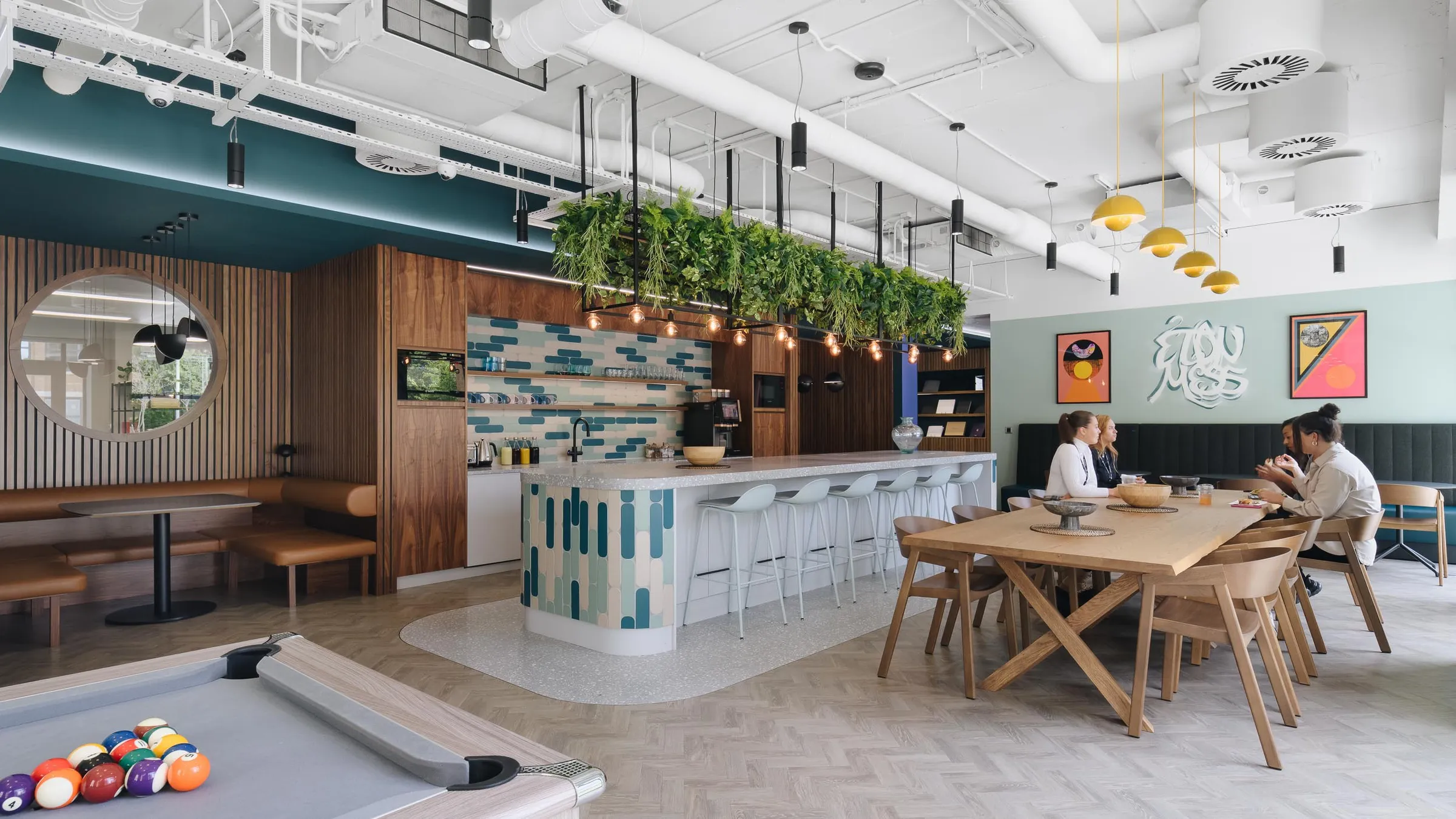Sustainable Workplace Design and Environmental Impact
One of our driving passions at Sketch Studios is creating a more sustainable world through intelligent and innovative workplace design. Read on for a round-up of all the key statistics about sustainable workplaces and their environmental impact.


Written by
Fritha Selwyn Jones
Contents
One of our core motivations at Sketch Studios is creating a more sustainable world through intelligent and innovative workplace design. Our commitment—and that of our clients—to driving positive change is so powerful, we must seize the opportunity to turn ambition into action. From the start, our approach has been one of making sustainable building and design choices because we know these choices, no matter how small, all contribute to a healthier environment, happier communities, and a brighter future for everyone.
The facts don’t lie when it comes to sustainable office design and furniture consultancy. Read on for a round-up of all the key statistics about sustainable workplaces and their environmental impact.


Green Building Practices in New Workplaces
Environmental, social, and governance commitments rightfully sit at the top of the priority list for so many businesses and investors. One of the most significant ways we can make a positive impact on ESG is through the passive power of a truly sustainable workplace, made with green building practices, to attain green building certifications. Not only are green workspaces good for the environment, but they are also good for productivity. Biophilic, greenhacking, and even adding a few more plants into the office are going to boost productivity and staff satisfaction.
Savills conducted research into the demand for certified green office spaces, analysing the distribution of LEED, BREEAM, and WELL-certified office spaces as well as green-certified space as a share in total stock for cities across the globe.The US came out on top as having the most cities with the highest percentage of green-certified space. The top 20 cities averaged 28% green-certified total stock, meaning that 70% would need to be retrofitted. Given the current demands for green-certified buildings in the investment market, this will be driven by investors as well as occupiers.
Sarah Dreyer, Senior Vice President, Head of Americas Research, Savills, pointed out that companies are trying to encourage employees to use office space more often after the changes that came during the lockdown, and sustainability is one of these drivers.
Examples of Green Building Practices in New Workplaces
Use sustainable building materials: Opt for reclaimed, recycled or rapidly renewable materials like bamboo, cork or recycled steel.
Prioritise modular construction: Modular designs reduce waste and allow for easier reconfiguration or deconstruction.
Target green building certifications: Aim for certifications such as BREEAM or LEED to benchmark and guide sustainable practices.
Design for longevity and adaptability: Flexible spaces reduce the need for future renovations, which often carry environmental costs.
Integrate renewable energy sources: Incorporate solar panels, wind turbines or green roofs where feasible to reduce carbon footprint.
Sustainable Design and Employee Wellbeing
Sustainability in the workplace is incredibly important for employee wellbeing. Not only does it promote productivity, but it also ensures health and wellness among employees.
The World Green Building Council’s report on Building the Business Case: Health, Wellbeing and Productivity in Green Offices presented eight key design elements for a more sustainable workplace that supports employee wellbeing in this diagram. Even ensuring one of these features will do wonders for an office space.

Image source: worldgbc.org
Following this guidance produces workplaces that are healthier and more sensorially enjoyable. The move towards sustainability in society at large has had an enormous impact on how individuals perceive the places they work, their choices in where they work, and their contentment in their workplaces.
The Design of the Workplace Report, published by Foster + Partners and Brookfield Properties, looked into employees’ perceptions and opinions about sustainability in the workplace. The report found that:
90% of office workers believe a sustainable workplace is good for their own wellbeing and the planet.
81% believe their company should be run in a climate-conscious and sustainable way.
35% of 18–20-year-olds would consider leaving if their employer didn’t demonstrate a commitment to sustainable initiatives.
81% of 18–29 year olds say that sustainable running of the company they work for is a high priority.
24% feel their mental and physical health is impaired by a workplace that is not environmentally friendly.
93% feel happier working in an environmentally friendly office.
92% feel more job security in offices that prioritise environmental initiatives.
93% of those working in environmentally friendly workplaces agreed that they were happy with their job.
Respondents to a survey in the report from environmentally friendly and environmentally unfriendly workplaces were asked about their views on how their employers engaged with their needs. The results showed that those in environmentally friendly workplaces felt more heard and supported by their employers.
Question | Environmentally Friendly | Environmentally Unfriendly |
Does the company give attention to staff training? | 40% | 26% |
Does the company promote diversity and inclusion? | 38% | 27% |
Does the company listen to and respond to the needs of staff? | 40% | 26% |
Sustainable Office Design and Employee Wellbeing Tips
Incorporate biophilic elements: Plants, green walls and views of nature improve air quality and support mental wellbeing.
Provide ergonomic furniture: Sustainability doesn’t stop at the materials - well-designed furniture also improves physical health and productivity.
Control indoor air quality: Use low-VOC paints, proper ventilation, and air purifiers to maintain a healthy environment.
Design for natural rhythms: Use lighting that supports circadian rhythms to help reduce fatigue and boost focus.
Create quiet and restorative spaces: Include zones for privacy, relaxation or meditation to support mental health.


Flexible Working and Sustainability
Flexible workspaces are thought to be more environmentally sustainable, according to 53% of employees. It’s true that new, flexible work models that arose out of the pandemic have paved the way for greater sustainability in workplace design.
A study on operational energy consumption in the post-pandemic era looked into how the evolving needs of the workplace would change energy usage.
The study found that workers and employers were redefining their work habits with more dynamic work patterns. The future office would be seen as a space primarily for community building, social interaction, and knowledge exchange. The adoption of flexible hybrid working models was expected to see a drop in energy consumption of up to 50% of that of pre-pandemic levels. These new ways of working would not only reduce energy consumption but, by proxy, improve ventilation and space usage and fulfil the diverse needs of all team members.
Coworking spaces have also been on the rise since the pandemic, thanks to higher demand from both workers and employers. Coworking spaces use 25% less power than traditional workspaces on average. Coworking spaces also produce up to 50% less greenhouse gas emissions. Of all coworking spaces, 62% implement initiatives like recycling to help strive for sustainability goals.
Flexible workspaces also contribute to better sustainability by embracing technological, paperless approaches to work. 70% enable access via apps and digital cards, 57% use apps to book spaces and connect with members, and 23% provide digital mailboxes.
Examples of Flexible Working and Office Sustainability
Support remote and hybrid working: Reduces the need for physical office space and cuts down on commuting emissions.
Hot-desking with smart systems: Encourages resource sharing and reduces the footprint of underutilised workstations.
Digitise workflows: Minimise paper use and office supply consumption through cloud-based tools.
Promote alternative commuting: Provide secure bike storage, EV charging points and travel incentives to reduce car use.
Monitor and manage occupancy levels: Use data to optimise space utilisation and inform decisions about downsizing or restructuring.

Is your workplace changing shape? Do you have sustainability goals that need to be fulfilled? Intelligence and creative workplace design can give you a foundation on which to reach sustainability achievements like net-zero carbon emissions. Talk to Sketch Studios today to find out how we can help.
Top 10 Sustainable Workplace Questions You Need to Know
Top 10 Sustainable Workplace Questions You Need to Know
1. What is a sustainable workplace?
A sustainable workplace is a work environment designed to minimise its ecological footprint by efficiently using environmental friendly technologies, reducing waste, and promoting eco-friendly practices throughout the office. It involves everything from energy-efficient buildings to sustainable materials, all aiming to create a work culture that values both environmental stewardship and employee satisfaction.
2. How can employees be sustainable?
Employees can be sustainable by adopting eco-friendly habits such as reducing paper usage, recycling, conserving energy, and opting for sustainable commuting methods like cycling or carpooling. They can also support the company’s sustainability initiatives by making mindful choices in their daily tasks.
3. How to work sustainably?
Working sustainably involves making conscious decisions that reduce environmental impact, such as utilising digital documents instead of printing, turning off equipment when not in use, and choosing energy-efficient appliances. Additionally, prioritising remote work or flexible schedules can reduce the carbon footprint associated with commuting.
4. How to make an office eco-friendlier?
To make an office eco-friendlier, implement energy-saving measures like LED lighting, install recycling stations, use sustainable materials for office furniture, and encourage a paperless work environment. Incorporating plants can also improve air quality and employee well-being.
5. What is an example of sustainability at work?
An example of sustainability at work could be a company-wide initiative to reduce plastic waste, such as providing reusable water bottles and eliminating single-use plastics from the office. Another example is implementing a comprehensive recycling program that includes electronics and office supplies.
6. What is a sustainable workforce?
A sustainable workforce prioritises minimising environmental impact while ensuring the long-term well-being of employees. This includes fair wages, healthy work conditions, continuous learning opportunities, supporting a healthy work-life balance., all contributing to a more resilient and productive team.
7. Why do you work in sustainability?
Working in sustainability allows individuals to contribute to a more balanced relationship between human activity and the natural environment. It’s a field that focuses on creating long-term solutions to environmental challenges, helping to ensure a healthy planet for future generations while fostering innovation and positive change.
8. How to build a sustainable workplace?
Building a sustainable workplace involves integrating eco-friendly design principles into the office infrastructure, such as using renewable energy sources, incorporating sustainable materials, using smart technology that monitor energy consumption and designing spaces that maximise natural light and ventilation. Additionally, fostering a culture of sustainability through employee engagement and training is essential.
9. What does a sustainable workplace look like?
A sustainable workplace often features open spaces with plenty of natural light, energy-efficient appliances, and furniture made from recycled or sustainably sourced materials. It may also include green spaces, such as rooftop gardens, and facilities for recycling and composting. The atmosphere is one of mindfulness and respect for the environment.
10. What is a sustainable work culture?
A sustainable work culture is one where environmental and social responsibility are embedded into the organisation’s values and practices. Employees are encouraged to make eco-friendly choices, and the company actively promotes initiatives that reduce its overall impact on the planet. This culture supports not only the environment but also the well-being and development of its employees.
Published on
November 28, 2023













